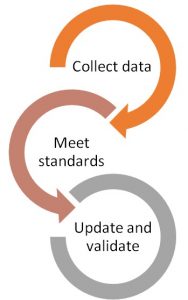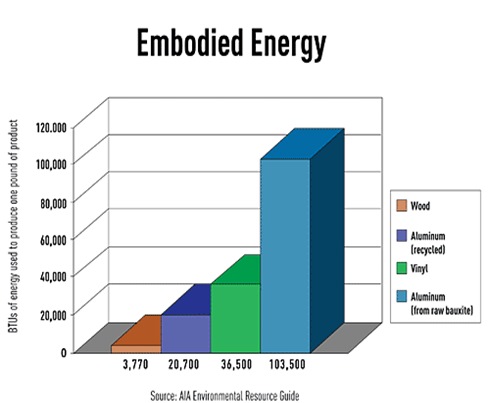by Kion Gibbs and Dorothy Scholnick — August 2018
When considering the benefits of an asset management program, sustainability may not be one that comes to mind. Though, a robust asset management program, which begins with properly conducting and maintaining an inventory over time, may be one of the most beneficial initiatives that Facility Managers (FMs) can implement for the sustainability of their organization. Asset management programs are a sustainable effort in that they provide the opportunity to reduce embodied energy involved in asset maintenance by getting the most value out of your resources including: labor time, equipment life, and other financial and energy investments.
Definition: Embodied energy is the sum of all the energy associated with a building, from the collection of energy, to transporting it to the building, to consuming it within the building.
Embodied energy exists in various forms but can be broken down into two types: initial and recurring embodied energy. Though, difficult to calculate, initial embodied energy is characterized by the amount of non-renewable energy that goes into sourcing the materials, processing, transportation, and construction (refer to Image 1); whereas recurring embodied energy is the energy involved in maintenance, repair, and replacement after the component has been installed. An asset inventory helps to reduce recurring embodied energy by creating the basis for a proper asset management program that allows the facilities organization to optimize equipment performance, extend the useful life of equipment, thus reducing the frequency of repair and replacement.
To get the most out of the equipment you have invested in, the first step is to know what you have. The foundation of an effective asset management program is an up-to-date and accurate asset inventory. Once an asset inventory is developed, the data can be used to track equipment history and preventive maintenance tasks tied to each asset, providing insight into resources invested and the current condition, which sets the ground work for a sustainable asset management effort.
In an ideal world, asset inventories are prepared as facilities are constructed and turned over to the FM in a nice, neat package detailing all the equipment that just went into the building.
More commonly, FMs are inheriting facilities with piecemeal inventories that have been compiled throughout the life of the building, or no inventory at all. They may have some accurate data, but more likely there is missing data and/or equipment to be added, as well as outdated equipment that should be removed or archived. Developing an accurate asset inventory involves the same basic steps:
- Identify data standards in use or the need for data standards based on any existing data, and how it will be used (i.e. preventive maintenance schedules, work orders).
- Identify the capabilities of the FM technology that you have now for managing an asset inventory or identify the capabilities you are looking for in a software provider.
- Determine the list of maintainable assets to manage in FM technology.
- Develop data standards following the FM technology capabilities and needs for the maintainable assets (i.e. asset type, ID, attributes).
- Identify the criticality of major equipment types (based on type or service area).
- Determine a parent/child relationship for the asset types, if applicable.
- Perform inventory and implement labeling with barcodes or QR codes if the FM technology supports reading of the labels.
- Develop a process to maintain asset data over time.
Depending on your starting point, whether you:
- have no asset data in FM technology (new construction or existing building);
- have some existing asset data in FM technology and are looking to validate/update; or
- have some existing asset data in FM technology and are transitioning to a new software,
the specific steps to achieve an accurate and up-to-date asset inventory may vary. However, the general process will follow the steps listed above.
With the foundation of your asset management program set after collection of your inventory, you are poised to embark on your sustainable asset management effort. As previously mentioned, the program will allow your organization to reduce the embodied energy that goes into your facilities in various ways, including but not limited to: labor time and equipment life. The reduction in embodied energy will be reflected in the increased efficiency and effectiveness of your facilities, which in turn can reduce operating and replacement costs, thus fostering economic and environmental sustainability.
Labor Time
One of the pieces of information collected during an asset inventory that can be utilized to enhance the efficiency of the facilities organization is location. The size of your portfolio dictates the extent of the asset location, but typically it will include, at a minimum, the building and area – whether that is a room, a corridor, roof, or other specific location. As technicians are assigned to work orders, they will be provided with the asset location, which allows them to plan the most effective route through the building or campus to complete their tasks. This information can greatly reduce the energy involved in excessive travel while searching for equipment or a disadvantageous maintenance route.
Most FM technology has the capability of loading assets along with specific fields, such as maintenance task lists, asset parts, required tools and supplies, etc. Just as the technician is equipped with the location of the asset, they are also provided with this information upon receipt of planned work orders, which serves a two-fold purpose:
- Technicians are equipped with all the information necessary to perform the work they have been assigned. There is little to no time spent researching the asset, what work needs to be performed, what parts, tools or supplies they might need. A robust asset management plan leads to more wrench time, which translates to a more efficient workforce.
- Knowledge does not solely live within the technicians. Some organizations do not have documented processes, work order tasks included – the technicians are knowledgeable in their trades and have an idea of what work needs to be done, and when. But what happens when that technician leaves or retires? The knowledge goes with them and there is a steep learning curve for the next person to fill the position. Until the next person gets up to speed, the operation cannot be running as efficiently as possible – an asset management plan can eliminate, or greatly reduce the unproductive labor time associated with the learning curve of new hires.
The amount of embodied energy involved in the maintenance of assets is inclusive of the time and energy technicians invest in their care. Anything that can be done to increase the efficiency of maintenance operations can be seen as an economically sustainable measure, because it reduces expenditures for time that is not spent maintaining the facility and its assets. An asset management program does just that by providing technicians with the ability to effectively plan the optimal route to perform the work, as well as equipping the technicians with all of the information necessary to complete their tasks upfront.
Equipment Life
An asset management program serves many purposes, but chiefly it should ensure that a plan is in place to properly care for the major maintainable assets within an organization’s portfolio. Without diving too deep into the specifics, the most effective way to preserve equipment functionality is an optimal mix of preventive and predictive maintenance, what we call reliability centered maintenance (RCM). By maintaining assets to the highest degree, your organization will be supporting its sustainable initiative because assets will likely continue to function as they should for the expected useful life, and perhaps even beyond.
Regular maintenance, as often prescribed by manufacturers in O&M manuals, is intended to keep an asset from depreciating in functionality, efficiency, and effectiveness at an expedited rate. As assets experience losses in each area, they begin to require more input to produce the same, or even a lesser output. Failure to properly maintain assets directly effects the amount of energy that goes into their operation and care, as well as reducing their energy efficiency, therefore negatively impacting sustainable efforts.
Though, the daily focus of an FM may be on reducing recurring embodied energy through more efficient maintenance operations, they also have a hand to play in avoiding undue initial embodied energy. This can be incurred by premature disposal and replacement, which may occur because of asset failure due to insufficient care over the asset’s life. An asset management program allows the FM to assign criticality to assets, a characteristic that can help determine how technicians spend their time; or on which assets, rather. Criticality represents a scale of importance to the organization and can best be represented on a three-point, tiered scale:
Determination of criticality helps the FM organization assign priority to asset maintenance, with Criticality 1 assets receiving nearly 100% of the scheduled maintenance and Criticality 3 assets being run to failure. An asset management program inclusive of this determination supports a sustainable effort of reducing both initial and recurring embodied energy. It creates an emphasis on maintaining assets most important to the organization to ensure that they do not experience a degradation in performance requiring an increase in effort and energy input. Additionally, it effectively eliminates the recurring embodied energy involved in the maintenance of assets that do not have a high degree of return on investment.
Though, embodied energy is difficult to put into numbers as a measure of sustainability, it still offers an effective way to manage your sustainable efforts through an asset management program. Taking a deeper look at your approach to asset maintenance with the support of an asset inventory can create a more efficient FM operation through reduced labor time and prolonged asset lives, among many other benefits offered by asset management programs. The amount of effort and energy that goes into managing your assets should not increase as the output decreases; nor should you continue to spend money on inefficient practices that result in premature asset failure and replacement.
Take a look at your asset management program and see if there are ways in which you can reduce your organizations embodied energy.
Resources:
AIA Environmental Resource Guide. American Institute of Architects, 1999.
 Kion Gibbs is a Project Professional at Facility Engineering Associates. He has degrees in facility management and architecture and sustainability from Ferris State University and works under the facility consulting services line that specializes in facility asset management, building energy management, and sustainability services.
Kion Gibbs is a Project Professional at Facility Engineering Associates. He has degrees in facility management and architecture and sustainability from Ferris State University and works under the facility consulting services line that specializes in facility asset management, building energy management, and sustainability services.
 Dorothy Scholnick, FMP is a Project Professional at Facility Engineering Associates. She has a degree in facility management from Temple University and works under the facility consulting services line that specializes in facility asset management, building energy management, and sustainability services.
Dorothy Scholnick, FMP is a Project Professional at Facility Engineering Associates. She has a degree in facility management from Temple University and works under the facility consulting services line that specializes in facility asset management, building energy management, and sustainability services.

